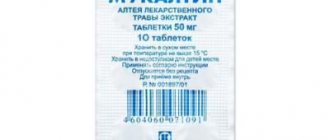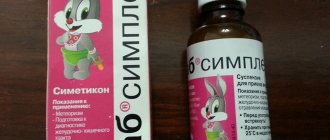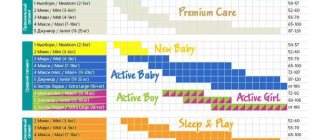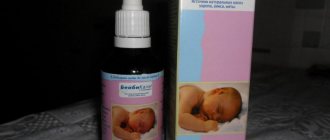Problems with stool in newborns are far from uncommon. In infants, the absence of stool for two to three days can be considered a variant of the norm and a phenomenon of “physiologically rare stool.” This is due to breast milk being almost completely digestible. But for artificial people everything is much more complicated.
Stool in newborn babies should be regular and have a soft, mushy consistency, so that there are no problems with bowel movements and the removal of waste substances from the body. If a child experiences constipation, this is always a problem, since he needs to be helped quickly, gently and delicately, without disrupting natural processes and without “addicting” the child to laxatives.
Composition and release form
Microlax is available in the form of a 5 ml solution, which is placed in microenemas. For newborns, the suppository can be easily inserted into the rectum. A box can contain up to 12 tubes.
Microlax children's suppositories contain sodium lauryl sulfoacetate, sorbitol and sodium citrate. The composition also includes auxiliary components such as water, sorbic acid and glycerin.
Indications for use
Microlax is recommended for a newborn if constipation was caused by the following factors:
- During the period of acquaintance with new products.
- Transition to artificial feeding.
- When there is a shortage of fluids, for example, during the hot season.
- Changing milk formulas.
- Lactation deficiency.
- Long-term drug treatment.
- Wrong diet for older children.
In addition, a laxative is prescribed for endoscopic and x-ray examinations when complete bowel movement is necessary.
When is it recommended to use Microlax?
In the first months of life, the newborn’s digestive system is not yet fully formed, so disorders such as flatulence, loose stools or constipation may occur. However, such phenomena are not always a deviation from the norm. For example, if your baby is breastfed, he may not have a bowel movement for up to 5 days.
But when is it advisable to give enemas to a baby?
- If a bottle-fed newborn does not have bowel movements on the 2nd day.
- If a baby does not go to the toilet for more than 2 days and is bothered by abdominal pain, he constantly presses his legs to his stomach, eats poorly, and is capricious.
- If the baby turns very red during bowel movements, strains, and cries.
- When a newborn defecates, hard feces with blood streaks or mucus are released.
But even here it is important to understand that enemas and suppositories do not solve the problem, they are only emergency aid for constipation. If the situation repeats again and again, then the child must be shown to a doctor. A newborn may have various intestinal pathologies, so the sooner you get examined, the better.
Advice
With periodic constipation in a newborn, it is important to identify the cause of the disorder before the disease becomes chronic.
Microlax enemas can be used from the first days of a baby’s life. The drug belongs to the group of combined laxatives and has a mild effect, which is especially important for the delicate and vulnerable intestines of a newborn. "Microlax" is a microenema made of polymer materials with a liquid solution inside. The drug is sold in 4 pieces per package, each of which has a volume of 5 ml and is used once. Microlax for newborns costs approximately 300 rubles per package.
Contraindications and side effects
The drug is recommended for infants who have allergic reactions to certain components of the drug. Contraindications include serious stomach diseases that are accompanied by bleeding. This also includes cracks and damage to the anus.
With prolonged use, the drug is addictive. Therefore, you must strictly adhere to the recommended doses and course of treatment. Side effects include diarrhea, allergic reactions and pain in various parts of the abdomen.
Special instructions.
Directions for use and dosage.
Microlax for newborns instructions for use:
- You can take the drug once a day to restore normal microflora in the intestines.
- We place the child on one side.
- Next, we tear off the seal from the tip of the microenema and insert it into the rectum.
- For children under three years of age, it is recommended to insert the tip only halfway.
- Press the tube so that the solution is completely poured into the rectum.
Two days of treatment is enough to restore the natural process of bowel movement. If you are unable to solve the problem, you should definitely consult a doctor who will select another effective remedy for the treatment of constipation.
Overdose
Thanks to special packaging, overdose is impossible. The drug is available in capsules that are administered to children into the rectum. One capsule is enough for a day to restore the natural process of bowel movements. Therefore, it is better not to overuse, so as not to wash away beneficial bacteria from the stomach.
How often to apply
Parents often have a question: how often can a microlax enema be given to a newborn? It is enough to give the baby a microenema twice to eliminate stagnant feces in the colon.
Features of using Microlax for newborns
Even if your baby has not yet had problems with bowel movements, you need to be prepared for this unpleasant phenomenon in advance. You, of course, know a couple of time-tested ways to cope with constipation, but using them on a newborn is highly undesirable.
A bar of soap, a thermometer or a cotton swab can damage the delicate tissues of the baby's anus. Not everything is simple with an enema - there is a risk of washing out beneficial microflora and getting used to this procedure. A possible option is to use laxatives, one of them is Microlax for newborns.
Why does a newborn need Microlax?
You should ensure that your breastfed baby's stool in the first weeks of life is mushy and yellowish.
Any lumps, especially sausage-shaped feces, should alert you. This is a sign of constipation; dense stool can damage the rectum and the newborn will involuntarily hold stool.
How does Microlax work? This drug, in the form of an enema solution, works exclusively in the rectum, softening stool and promoting its elimination.
The substances of the drug are not absorbed into the blood, therefore they are safe even for an infant. The medication is not addictive, so Microlax can be used for newborns.
Instructions for the drug
The Microlax package contains 4 microenemas of 5 ml each. Everything is sterile, the enema is opened immediately before use.
Attention! After opening the tube, storing it is strictly prohibited.
The drug contains 3 main active ingredients:
- Sodium citrate helps restore water balance in the baby's intestines. Water is needed to saturate stool and remove it painlessly from the body.
- Sodium lauryl sulfoacetate, in turn, acts as an additional irritant to the intestinal walls, promoting contraction and expulsion of feces.
- A 70% sorbitol solution increases the size of the intestines and improves its functioning.
Among the auxiliary components are the familiar glycerin and water, as well as sorbic acid. Glycerin softens and binds the masses, water thins it, and the acid acts as a preservative.
Indications for use
Before you buy the drug, you need to familiarize yourself with the indications for use of Microlax:
You will need this remedy if you suspect constipation in a newborn;
- If the baby behaves restlessly, curls up his legs and cries, his tummy is inflated and tight - these can also be symptoms of constipation. Although, you can easily make a mistake. To understand what is normal and what is not in situations with an infant’s stool, watch the online seminar Problems with an infant’s stool: how to safely help a child?>>>
- You can use the drug if the baby's stool has a harder consistency than usual, especially if the baby cries when he poops;
- Microlax may be useful for cleansing the intestines if you need to study the intestines using X-rays or rectoscopy for your baby.
There should be no doubt whether a newborn can take Microlax. The drug is approved for use from the first days of life. In addition, there is a special mark on the tube for infants, which will help you during the application process.
How to use?
In practice, you should not have any problems using microenemas. The procedure for administering Microlax to a newborn is simple and painless:
- First you need to prepare the place where you will carry out the manipulations. The table should be covered with an absorbent napkin, the baby should be calmed down and placed on his side, not forgetting to thoroughly wash his hands first;
- You take one tube and tear off the seal. Lubricate the tip itself a little with the contents;
- The baby lies on his side, his legs are slightly bent, you carefully lubricate the anus with Vaseline; Also, you may be interested in using Vaseline oil. Read about this in the article: Vaseline oil for a newborn> >>
- Please note that there are marks on the tip of the drug; you need to insert the tube into the baby’s anus no more than two and a half centimeters. For children up to the age of three, you squeeze out half of the contents. From 3 years and older, use a full tube;
- You need to gradually squeeze the contents of the tube inside. Then, without letting go of the tube, you pull it out in this squeezing position;
- You need to wait about 5-15 minutes for the drug to take effect. At this time, you can help your baby cope with unpleasant sensations by doing a light tummy massage and circular stroking in the navel area;
- If your baby hasn't pooped after thirty minutes, don't be alarmed. Give him some water to drink and place him on his tummy.
Despite the positive effect of Microlax, the instructions for use for newborns indicate that the product is not therapeutic. It only helps to empty the bowels and softens the stool. The problem of constipation needs to be identified and regulated through the nutrition of the nursing mother. To figure out what you can eat and what it’s better to abstain from, see the course Nutrition for a nursing mother without harm to the baby>>>
Side effects, contraindications
Like any other medical product, Microlax has contraindications and side effects. The risk of their occurrence is small, but you should be aware of them.
- You will have to refuse the drug if there is an individual intolerance to at least one of the components of Microlax;
- If your baby has cracks in the anus, he may feel burning and itching. But apart from unpleasant sensations, there should be no other consequences;
- You should use the drug with caution if the newborn has a clear allergic predisposition. The components may cause allergic redness and itching, especially with prolonged use. But if your baby does not have a hypersensitive predisposition, then you should not be afraid.
In any case, this drug is not a panacea for constipation, it only helps to empty the intestines, and treatment and elimination of the causes of intestinal dysfunction must be carried out in parallel.
Microlax and its analogues: which is better?
Microlax is produced under the auspices of the company Johnsons & Johnsons, its price is around 230 rubles for 4 microenemas, there is a manufacturer called Famar Orleans, this option is more expensive - 340-380 rubles.
The pharmacy chain may offer you analogues of a laxative. But you should know that you will not find structural analogues, that is, drugs containing all the active ingredients that are in Microlax. Pharmacists can only advise you on drugs that also have a laxative effect and act locally in the intestines.
- Glycerin suppositories. They are much cheaper, 120 rubles for 10 suppositories, but have only a partial effect; they lubricate and bind the fecal mixture. It takes some time for the drug to dissolve and begin to act. In this comparative characteristic, Microlax is the clear leader;
- Duphalac. This is no longer an enema, but a syrup for internal use. Can be used from birth and during breastfeeding for the mother, and for a long time. But the price of this drug is not cheaper - from 500 rubles. And the duration of action is after 12 hours from the moment of administration.
- Normacol. Also in the form of an enema, but not suitable for newborns. Price – from 300 rubles.
Thus, you are unlikely to be able to replace Microlax, since despite the large range of laxatives, only a few are suitable for newborns. In addition, as much as Microlax costs, there are other drugs in the same price range.
See also my short video tutorial about baby stool:
Reviews from moms
If you still doubt whether Microlax is right for you, look at the reviews on use from mothers who have already used the drug:
- Alina, mother of 4-year-old Egor;
She says that throughout these 4 years she has turned to this drug more than once. When her baby is sick with acute respiratory viral infections or the flu, he becomes dehydrated and, as a result, constipated.
There are emergency cases when the baby cannot go to the toilet and it torments him. Mom writes that the drug takes effect within five minutes and is very convenient to use. And regarding Duphalac, the woman notes that sometimes waiting 12 hours for her son to go to the toilet is too painful.
Another positive review comes from the mother of an artificial baby. The milk disappeared from the age of two weeks and I had to switch to formula. And immediately problems with stool began. Constipation has become a common occurrence, and Microlax was able to help quickly and painlessly.
Doubts about how often Microlax can be used for newborns have gone away on their own. We used it quite often, but there was no addiction.
The mother of a newborn baby also shared her impressions of the drug. I tried Microlax right in the maternity hospital, but for myself. The effect was excellent. Later, at two weeks of age, the baby had delayed stool, but I listened to Lyudmila’s seminar on baby stool in time and was able to avoid wrong actions.
Now I can definitely distinguish where the stool is normal and where my child needs help, but I help him in the natural way that is described in the seminar Problems with stool in infants. Once, on the advice of friends, I replaced Microlax with glycerin and suppositories. Apart from the baby crying and the melted liquid completely leaking out, nothing happened.
Be healthy! And let you and your baby suffer as little as possible from constipation and intestinal disorders!
If the drug does not help
If you follow the recommended dosage, you can get a laxative effect within a few minutes. In most cases, five minutes after the enema, the natural process of bowel movement is restored. If the drug does not work half an hour after taking it, you should definitely consult a doctor.
A circular massage of the abdomen in a clockwise direction will help restore natural digestive processes. The main thing is to move smoothly and rhythmically to stimulate the muscles of the gastrointestinal tract.
Analogs
In the pharmacy you can find similar drugs that allow you to dilute hardened stool and speed up the natural processes of defecation:
- Glycerin suppositories. An excellent option for children who cannot swallow tablets. Glycerin is completely safe for children. Suppositories dilute stool and remove it naturally.
- Duphalac. The drug is available in the form of syrup. The advantages of the drug include the possibility of use from the first days of life. In addition, the drug can be used until the normal functioning of the gastrointestinal tract is completely restored. The drug can also be used during breastfeeding.
Budget drug substitutes
The price of Microlax for newborns is about 300 rubles. per package. Due to the objective high cost of this product, many mothers use analogues of Microlax, which significantly save the family budget. The principle of operation of each of them is significantly different.
- Glycerin suppositories. Cost: 20-50 rub. As an option, use Glycelax suppositories, but their cost starts from 140 rubles.
Suppositories that are administered rectally. For a newborn child, it is enough to administer 0.5 suppositories to obtain the desired result.
Cons : more difficult to administer to a child, storage only in the refrigerator, hands get dirty.
- Small enema bulb. Their approximate cost: 25 rubles.
Cleansing enemas are performed to remove intestinal contents.
A small rubber container into which warm water/herbal decoctions are filled and administered to the baby in order to liquefy the stool.
Cons : a certain temperature of the injected liquid is required, a lot of time to prepare the procedure, painful insertion and discomfort for the child, a lot of cleaning after the procedure.
- Lactulose syrup . They cost from 200 rubles. and higher.
Product for oral use (Normaze, Duphalac, Goodluck, Lactulose). Fights the cause of constipation, improves intestinal microflora. Gradually forms the formation of regular stool.
Cons : approved for use no earlier than 6 weeks of age, the effect of the medicine occurs within 3-4 days.
Unfortunately, there are no microenemas similar to Microlax for newborns at a lower price in pharmacies today .
But it’s worth thinking about whether you need to save on your own child’s health. Caring for a newborn should include the organization of a sleeping place, because up to a year the child spends almost all the time in the crib.
We recommend that you learn how to choose the right mattress for a newborn.
If there is a problem of constant constipation in a child, you should pay attention not only to reviews of Microlax for newborns, but also contact your doctor.
Based on the tests and diagnosis, the baby will be prescribed appropriate treatment to restore regular bowel movements. The disease must be treated from the inside. And Microlax enemas, also intended for newborns, will help cope with unpleasant consequences and make life easier for mother and baby.











